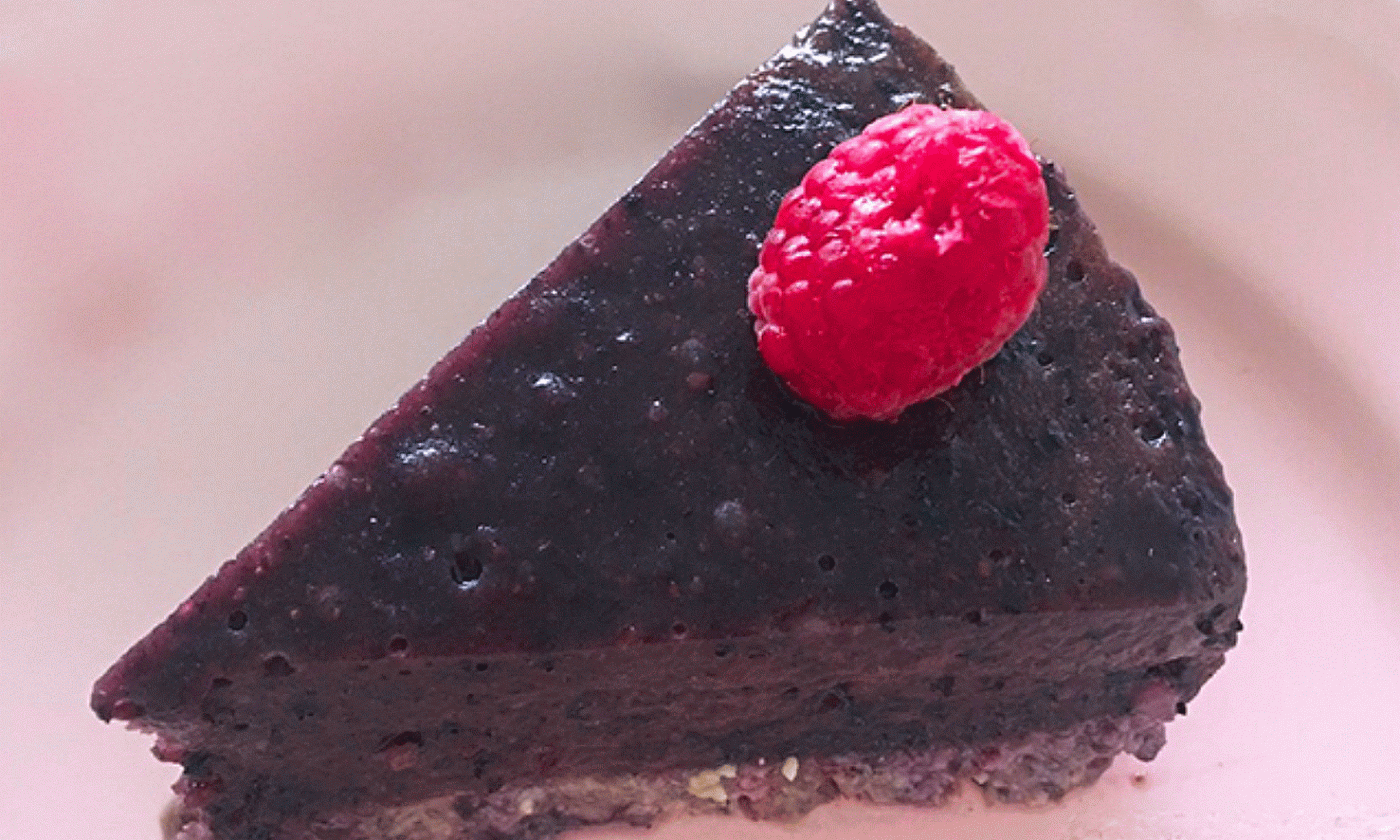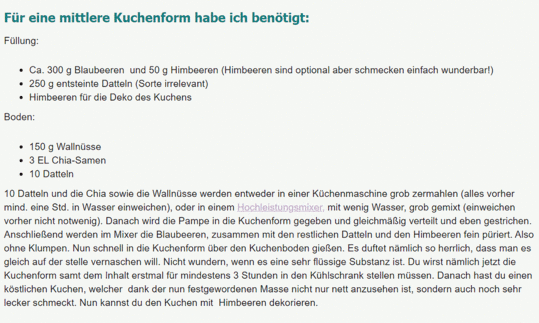Sweet raw vegan blueberry cake with walnuts, chia seeds
raw-vegan
Ingredients (for servings, )
| For the floor | |
|---|---|
| 5 ½ oz | Walnuts (tree nuts), raw (organic?) |
| 3 tbsp | Chia (chia seeds), raw, organic? (0.55 oz) |
| 10 | Dates, variety Deglet Nour, pitted, raw?, (organic?) (2.5 oz) |
| For the topping | |
| 11 oz | Blueberries (blueberries), raw (organic?) |
| 1 ¾ oz | Raspberries (wild raspberries), raw (organic?) |
| 4 ½ oz | Dates, variety Deglet Nour, pitted, raw?, (organic?) |
Equipment
- blender
- baking pan (springform pan)
- refrigerator
Type of preparation
- chop or grind
- soak
- blend
- cool
- purée
Preparation
Preparation - Soaking (optional)
Soak the walnuts and chia seeds for about an hour. This is not necessary, but it makes the mixing process easier. If you have a powerful blender, you can skip this step.If you soak the nuts and seeds, you do not need to add water in the next step as this will enrich the ingredients with liquid.
For the floor
Roughly chop the walnuts together with the chia seeds, the pitted dates and a little water in a high-performance blender.
Then pour the mixture into a medium-sized cake tin, spread it evenly and smooth it out.Optimal springform pan size: A springform pan with a diameter of approx. 20 cm (Ø) is best for this cake.
The pectins contained in the blueberries act as a natural gelling agent, which means that the initially liquid cake topping turns into a firm mass after being kept in the refrigerator.
For the topping
Puree the blueberries together with the pitted dates and raspberries in a blender until you get a fine mixture.In the original recipe, twice the amount of dates is used for the cake topping. We deliberately halved them to reduce the sugar content and tried it out ourselves.
Now pour the mixture over the cake base. Don't be surprised if it is a very liquid substance. Now put the cake in the fridge for at least 3 hours so that the mixture solidifies.
Serving the cake
Take the cake out of the fridge, decorate with fresh raspberries if desired and serve immediately.
|
Nutritional Information per person
Convert per 100g
|
2000 kcal | |
|---|---|---|
| Energy | 226 kcal | 11.3% |
| Fat/Lipids | 13 g | 18.7% |
| Saturated Fats | 1.2 g | 6.2% |
| Carbohydrates (inc.dietary fiber) | 28 g | 10.4% |
| Sugars | 20 g | 22.2% |
| Fiber | 5.2 g | 20.8% |
| Protein/Albumin | 4.1 g | 8.3% |
| Cooking Salt (Na:1.6 mg) | 4.1 mg | 0.2% |
| Essential micronutrients with the highest proportions | per person | 2000 kcal | |
|---|---|---|---|
| Fat | Alpha-Linolenic acid; ALA; 18:3 omega-3 | 2.1 g | 104.0% |
| Fat | Linoleic acid; LA; 18:2 omega-6 | 7.3 g | 73.0% |
| Min | Manganese, Mn | 0.93 mg | 46.0% |
| Min | Copper, Cu | 0.39 mg | 39.0% |
| Prot | Tryptophan (Trp, W) | 0.04 g | 18.0% |
| Elem | Phosphorus, P | 103 mg | 15.0% |
| Prot | Threonine (Thr, T, irreversibly transaminated) | 0.14 g | 15.0% |
| Vit | Vitamin B7 (Biotin, ex vitamin H) | 7.5 µg | 15.0% |
| Elem | Potassium, K | 290 mg | 14.0% |
| Vit | Vitamin B9, B11 (Folate, as the active form of folic acid) | 28 µg | 14.0% |
Detailed Nutritional Information per Person for this Recipe
The majority of the nutritional information comes from the USDA (US Department of Agriculture). This means that the information for natural products is often incomplete or only given within broader categories, whereas in most cases products made from these have more complete information displayed.
If we take flaxseed, for example, the important essential amino acid ALA (omega-3) is only included in an overarching category whereas for flaxseed oil ALA is listed specifically. In time, we will be able to change this, but it will require a lot of work. An “i” appears behind ingredients that have been adjusted and an explanation appears when you hover over this symbol.
For Erb Muesli, the original calculations resulted in 48 % of the daily requirement of ALA — but with the correction, we see that the muesli actually covers >100 % of the necessary recommendation for the omega-3 fatty acid ALA. Our goal is to eventually be able to compare the nutritional value of our recipes with those that are used in conventional western lifestyles.
| Essential fatty acids | per person | 2000 kcal |
|---|---|---|
| Alpha-Linolenic acid; ALA; 18:3 omega-3 | 2.1 g | 104.0% |
| Linoleic acid; LA; 18:2 omega-6 | 7.3 g | 73.0% |
| Essential amino acids | per person | 2000 kcal |
|---|---|---|
| Tryptophan (Trp, W) | 0.04 g | 18.0% |
| Threonine (Thr, T, irreversibly transaminated) | 0.14 g | 15.0% |
| Isoleucine (Ile, I) | 0.15 g | 12.0% |
| Leucine (Leu, L) | 0.28 g | 12.0% |
| Valin (Val, V) | 0.19 g | 12.0% |
| Phenylalanine (Phe, F) | 0.18 g | 11.0% |
| Methionine (Met, M) | 0.07 g | 7.0% |
| Lysine (Lys, K, irreversibly transaminated) | 0.12 g | 6.0% |
| Vitamins | per person | 2000 kcal |
|---|---|---|
| Vitamin B7 (Biotin, ex vitamin H) | 7.5 µg | 15.0% |
| Vitamin B9, B11 (Folate, as the active form of folic acid) | 28 µg | 14.0% |
| Vitamin B6 (pyridoxine) | 0.16 mg | 12.0% |
| Vitamin K | 8.9 µg | 12.0% |
| Vitamin B1 (Thiamine) | 0.10 mg | 10.0% |
| Vitamin C (ascorbic acid) | 5.6 mg | 7.0% |
| Vitamin B3 (Niacin) | 0.89 mg | 6.0% |
| Vitamin B2 (Riboflavin) | 0.06 mg | 5.0% |
| Vitamin B5 (Pantothenic acid) | 0.32 mg | 5.0% |
| Vitamin E, as a-TEs | 0.42 mg | 4.0% |
| Vitamin A, as RAE | 1.5 µg | < 0.1% |
| Essential macroelements (macronutrients) | per person | 2000 kcal |
|---|---|---|
| Phosphorus, P | 103 mg | 15.0% |
| Potassium, K | 290 mg | 14.0% |
| Magnesium, Mg | 50 mg | 13.0% |
| Calcium, Ca | 44 mg | 6.0% |
| Sodium, Na | 1.6 mg | < 0.1% |
| Essential trace elements (micronutrients) | per person | 2000 kcal |
|---|---|---|
| Manganese, Mn | 0.93 mg | 46.0% |
| Copper, Cu | 0.39 mg | 39.0% |
| Iron, Fe | 1.1 mg | 8.0% |
| Zinc, Zn | 0.83 mg | 8.0% |
| Selenium, Se | 2.8 µg | 5.0% |
| Iod, I (Jod, J) | 1.2 µg | 1.0% |
| Fluorine, F | 1.2 µg | < 0.1% |
The sweet raw vegan blueberry cake with walnuts, chia seeds and dates contains lots of healthy omega-3 fatty acids. It is also easy to prepare.
Optimal springform pan size: A springform pan with a diameter of approx. 20 cm (Ø) is best for this cake.
Preparation time: The optional soaking time for walnuts is not included in the preparation time.
Nutrient profile: According to GDA guidelines, one portion of the cake covers the average daily requirement of omega-3 fatty acids and almost 50% of that of manganese. The ratio of omega-6 to omega-3 fatty acids is 4:1, which is below the recommended maximum ratio of 5:1.
Walnut: The real walnut, also called tree nut, has the highest proportion of linolenic acid (an omega-3 fatty acid that is healthy for the heart) of all nuts. They are also rich in vitamin E, zinc (an important trace element for the liver and hair, among other things) and potassium (for the heart muscle, among other things).
Blueberries or cultivated blueberries: According to scientific studies, blueberries have one of the highest antioxidant potentials of all fruits. The Oxygen Radical Absorbance Capacity (ORAC) is 25 µmol Trolox equivalents per gram of fresh weight. This is a measure of the ability of a food to neutralize free radicals. The higher the value, the more antioxidant the food has.
Chia seeds: Chia seeds, which come from Mexico, are particularly characterized by their high content of calcium, iron, soluble fiber and omega-3 fatty acids. The iron content is about twice as high as in grains. Furthermore, the human organism can use the amino acid tryptophan to convert it into the neurotransmitter serotonin. The latter is generally considered to be a mood enhancer by conveying feelings of calm and inner satisfaction. Incidentally, around 95% of our serotonin content is stored in the gastrointestinal tract!
Dates: The date fruit with its honey-like sweet taste is actually a berry fruit. It is rich in vitamin B6 and the minerals copper and potassium. It also contains more fiber than conventional wholemeal bread. We have reduced the amount of dates by about half to reduce the sugar content. You can find further information at the following link: Vegans often eat unhealthily. Avoidable nutritional errors
Wash blueberries well: Blueberries you have picked yourself should be washed well before eating them raw and, if in doubt, cooked. This is important because, depending on the area, the risk of fox tapeworm infections cannot be ruled out.
Utilize the potential of chia seeds: Our body can benefit from the effects of many ingredients, especially by consuming ground seeds, since the seeds in unground form would mainly only provide fiber. Omega-3 fatty acids in particular should be given greater importance in our raw vegan diet.
Instead of fresh blueberries and raspberries, you can also use frozen berries. However, you must defrost them first.





